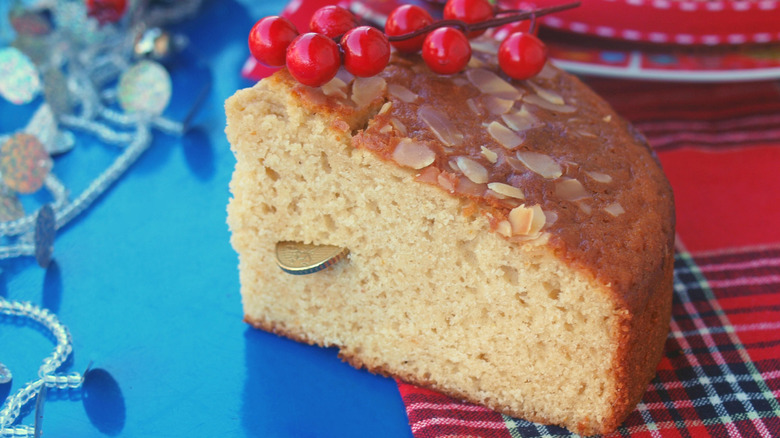The Special Greek Cake You Should Be Eating On New Year's
New Year's is a time for reflection, resolutions, and revisiting traditions. We may be biased, but our favorite New Year's traditions are the ones that involve food. From pork to grapes, there's something on the auspicious New Year's menu for everyone. If you're looking to add a fun, festive dessert to the rotation we highly recommend you consider Vasilopita.
Vasilopita is a bready type of king cake originating in Greece, made with ingredients you'd expect from a cake; Milk, sugar, fat, and eggs. What gives this cake a flavor and texture twist is the added citrus juice — like lemon or orange — for that subtle hint of acid and the almond slivers that give you a pleasant crunch to your bites. Vasilopita, which directly translates to "sweet bread of Saint Basil," is a celebratory dish that's typically served during special occasions like New Year's. Traditionally, vasilopita would come with a small (oven-safe) trinket or coin baked into the batter — legend has it that whoever ended up with the treasure inside their slice of vasilopita would go on to have a year filled with good fortune.
Vasilopita serving tips
Once the cake is out of the oven and has completely cooled, you can top your vasilopita with a white sugar glaze or powdered sugar. It's also customary to add a message or designs on the top using chocolate chips, M&M's, or a stencil under the powdered sugar. For New Year's celebrations specifically, you'll usually see the upcoming year in big bold numbers taking up the entirety of the top of the cake.
If you want to get extremely technical (and traditional) when serving the vasilopita, there's even a special, choreographed way to slice the cake. First, it's customary that the head of the household is in charge of slicing. They cut three pieces, representing the cross for Jesus Christ, the Virgin Mary, and the cake's namesake, Saint Basil. Then, another slice is cut as an offering to the household hosting the event, and each additional piece is cut for attendees and served in order of eldest to youngest. As you can imagine, the anticipation over which one of those slices contains the trinket is just about as fun as eating the dessert itself.

